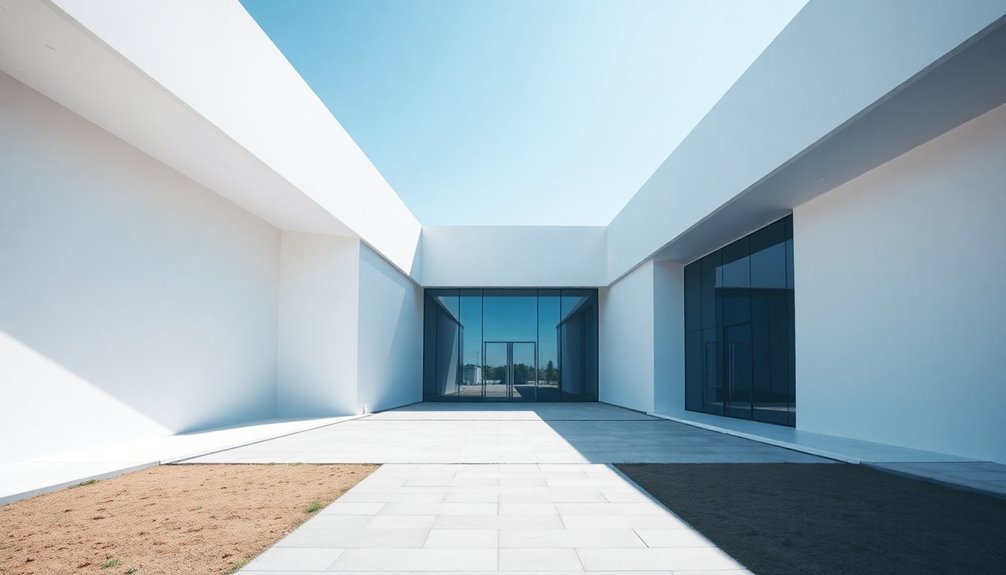Minimalist architecture embodies clean lines and simplicity, emphasizing function and natural beauty. You'll find that elements like open floor plans, neutral color palettes, and raw materials create calming spaces. Pioneers like Mies van der Rohe and Tadao Ando have shaped this aesthetic with their innovative designs. The philosophy of "less is more" resonates throughout, highlighting the importance of clarity. For a deeper understanding of minimalist masterpieces and their impact, you might explore further nuances of their design principles.
Key Takeaways
- Minimalist architecture emphasizes clean lines and geometric shapes, creating harmony and simplicity in design.
- Pioneers like Mies van der Rohe and Tadao Ando exemplify the "less is more" philosophy through their iconic works.
- Notable examples, such as the Farnsworth House, showcase seamless integration with nature and the environment.
- A neutral color palette and natural materials enhance the calming atmosphere characteristic of minimalist spaces.
- Innovative designs prioritize functionality and sustainability, reflecting a commitment to eco-friendly practices in contemporary architecture.
Origins of Minimalist Architecture
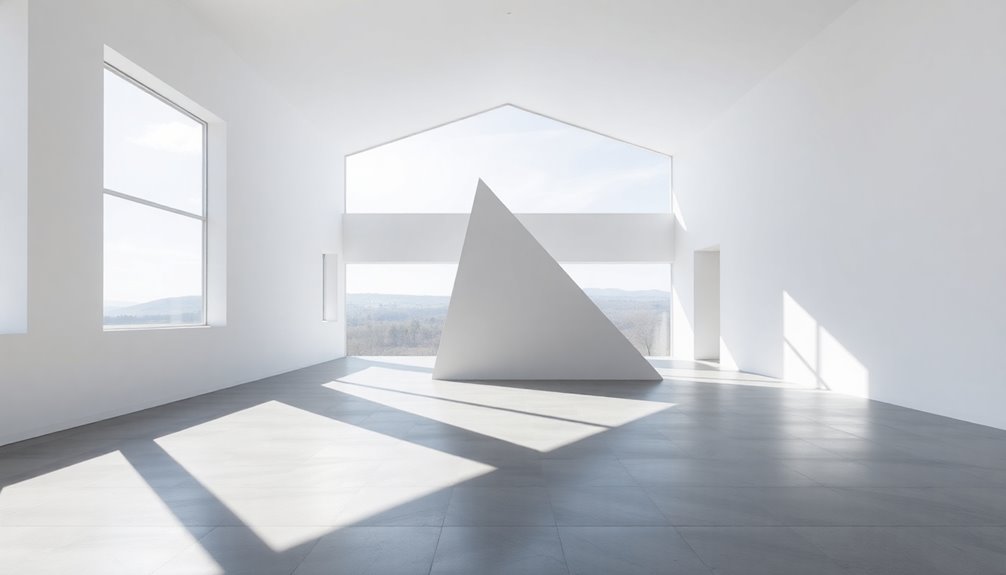
Minimalist architecture, which you might find striking in its simplicity, has roots that trace back to the early 20th century.
Emerging from the Bauhaus and De Stijl movements, this style emphasizes minimalism through clean lines and geometric shapes. The Bauhaus School, founded by Walter Gropius, championed the principle of "form follows function," laying the foundation for minimalist design.
Minimalist architecture, rooted in Bauhaus and De Stijl, champions clean lines and the principle of "form follows function."
Mies van der Rohe, a key figure in this movement, famously stated, "Less is more," encapsulating the essence of minimalist architecture.
Additionally, traditional Japanese design influences this movement, highlighting simplicity and a harmonious relationship with natural materials. This relationship with natural materials is also evident in other architectural styles, such as traditional Indonesian design, which emphasizes the use of wood and stone.
As you explore minimalist architecture, you'll appreciate how these principles converge to create spaces that are both functional and aesthetically pleasing.
Characteristics of Minimalist Design
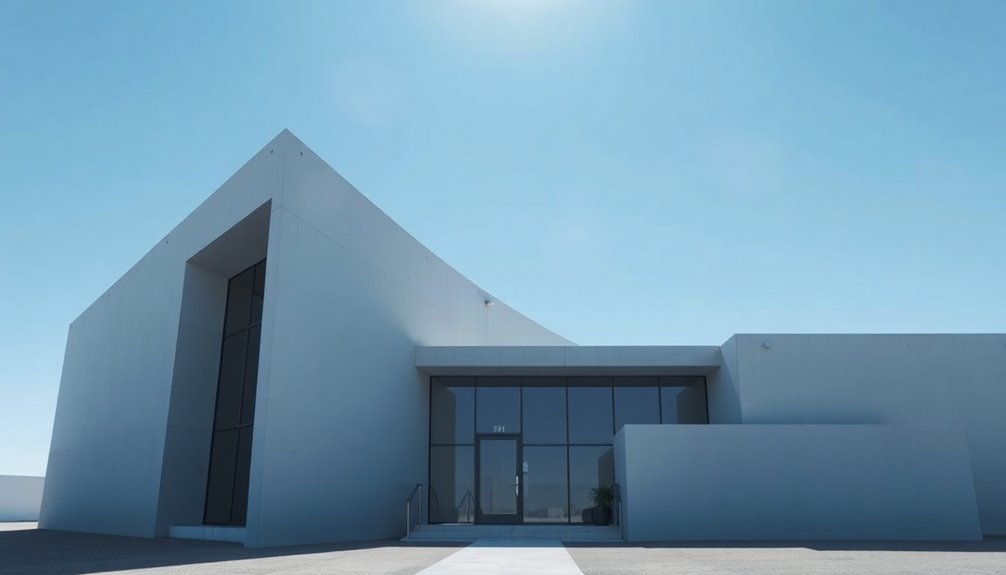
When you step into a minimalist space, you immediately notice the emphasis on simplicity that defines its design. Clean lines and geometric forms create a visually appealing environment, allowing you to focus on essential elements.
Functionality and simplicity are key, as open floor plans promote livability and practical use of space. You'll also appreciate the neutral color palette, featuring whites, grays, and earthy tones, which fosters a calming atmosphere.
Attention to detail is paramount in minimalist design, ensuring smooth shifts and precise alignment that enhance the overall clarity of the space. Incorporating natural materials like wood, glass, and stone not only harmonizes with the environment but also contributes to the tranquil ambiance found in these architectural masterpieces. This design philosophy often reflects intentional living, encouraging occupants to prioritize meaningful experiences over material possessions.
Pioneers of Minimalism: Influential Architects
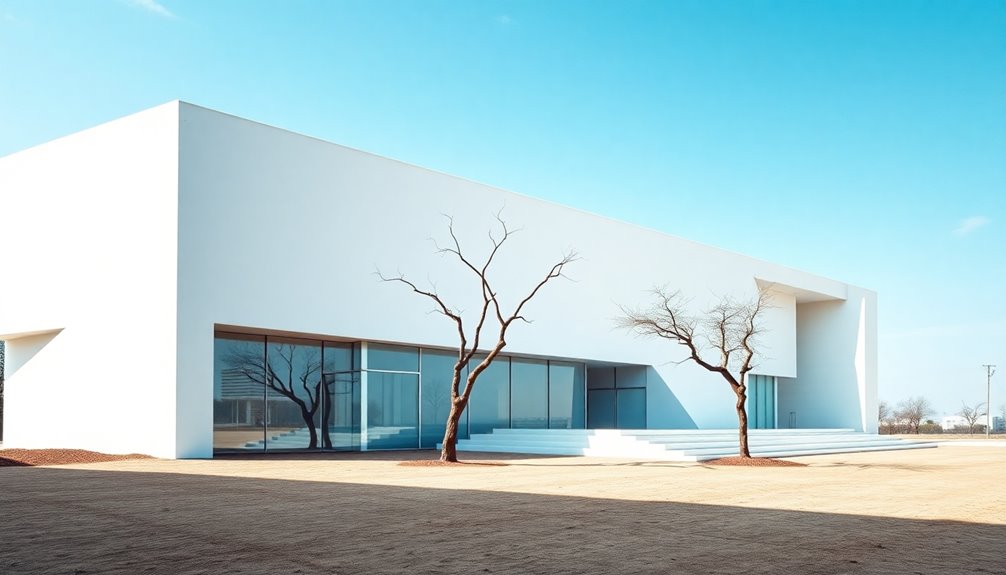
When you think about minimalist architecture, names like Ludwig Mies van der Rohe and Le Corbusier come to mind. Their innovative techniques and designs laid the groundwork for a legacy that continues to influence architects today. As you explore their contributions, you'll see how their focus on simplicity and clarity transformed architectural practices. Their work exemplifies the principles of cognitive CQ, showcasing how understanding cultural contexts can enhance design effectiveness.
Architectural Innovations and Techniques
While the minimalist movement has roots in the early 20th century, its impact on architecture continues to shape contemporary design. Influential architects like Ludwig Mies van der Rohe, Le Corbusier, and Philip Johnson pioneered a design philosophy centered on clean lines and transparency. Their work emphasizes the synergy of form and function with meticulous attention to detail.
Key innovations include:
- Expansive glass for blurred indoor-outdoor boundaries
- Neutral tones that enhance simplicity and serenity
- Open spaces that harmonize with natural elements
Contemporary architects like Tadao Ando and Kengo Kuma build on these principles, utilizing materials like concrete and recycled elements, showcasing the enduring relevance of minimalism in architecture. Additionally, the integration of solar energy solutions in new designs demonstrates a commitment to sustainability and environmental responsibility.
Legacy of Minimalist Architects
Minimalist architecture owes much of its enduring impact to the visionaries who shaped its principles. Mies van der Rohe's mantra, "Less is more," set the tone for modern design, reflected in his architectural masterpieces like the Barcelona Pavilion.
Philip Johnson, his protégé, embraced clean lines and natural materials in his Glass House, seamlessly blending indoor and outdoor spaces.
Le Corbusier's functional designs, such as Villa Savoye, showcased the beauty of simplicity and nature's integration.
Tadao Ando's use of raw concrete and natural light in the Church of the Light creates serene environments that elevate the spiritual experience.
Together, these architects laid the foundation for minimalist architecture, inspiring future generations to appreciate purity and elegance in design. Their work resonates with the principles of creating an interior design mood board, emphasizing the importance of cohesive aesthetics in architectural spaces.
The Philosophy of "Less Is More"
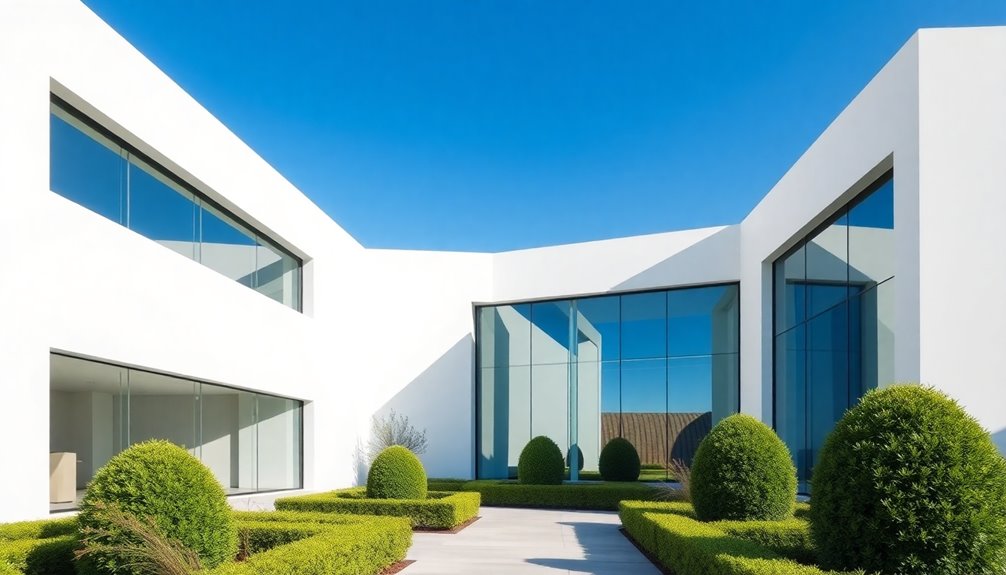
When you embrace the philosophy of "less is more," you start to see how simplicity can elevate both function and beauty in design.
By prioritizing essential elements over unnecessary decoration, you create spaces that aren't only visually appealing but also deeply practical.
This essence of minimalism invites you to appreciate the clarity and purpose in your surroundings. Moreover, adopting this approach can enhance your mental health by fostering a positive mindset.
Essence of Minimalism
Embracing the philosophy of "Less Is More" allows you to appreciate the profound beauty found in simplicity. This approach, championed by Ludwig Mies van der Rohe, highlights minimalist architecture's ability to evoke tranquility through clean lines and geometric forms.
By stripping away unnecessary elements, you reveal the essence of a space, where functional beauty reigns supreme.
- Utilize natural materials like wood and glass for visual appeal and sustainability.
- Emphasize the interplay of light and shadow to enhance architectural forms.
- Foster a harmonious relationship between form and function.
Through these principles, minimalist design creates environments that resonate with clarity, inviting you to experience the world in a more profound and meaningful way. Additionally, the use of natural materials in minimalist design can create a serene atmosphere reminiscent of Balinese interior aesthetics.
Functionality Over Decoration
In a world often overwhelmed by excess, the philosophy of "Less Is More" stands out by prioritizing functionality over decoration. Mies van der Rohe popularized this principle, emphasizing the importance of utility in minimalist architecture.
By focusing on how spaces are used, these architectural designs eliminate unnecessary elements, creating efficient and adaptable environments. Clean lines and geometric forms instill a sense of order, allowing you to navigate spaces intuitively.
Minimalist architecture often employs natural materials like wood, glass, and metal, enhancing both practicality and sustainability. Open floor plans exemplify functionality over decoration, fostering seamless flow between spaces and maximizing natural light.
This approach showcases how elegance can emerge from simplicity, proving that less truly can be more. Additionally, the integration of mood boards in the design process can help visualize the minimalist aesthetic while ensuring that each element serves a purpose.
Special Aspects of Minimalist Architecture
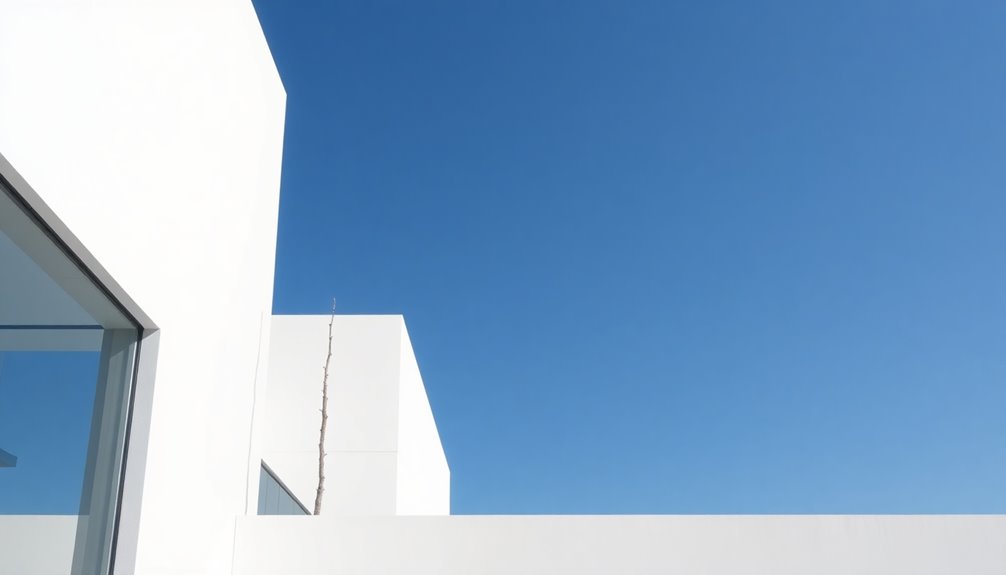
While many architectural styles prioritize embellishment and complexity, minimalist architecture stands out by focusing on simplicity and functionality.
This design philosophy emphasizes a harmonious blend of structure and nature, achieving aesthetic balance that calms the mind.
You'll notice that minimalist design employs:
- Clean lines and geometric shapes, promoting functionality
- Natural materials like wood, stone, and glass, enhancing tranquility
- A restrained color palette of neutral tones, ensuring visual harmony
Additionally, incorporating elements of Indonesian decorative pillows can add a vibrant touch to minimalist spaces without overwhelming the overall aesthetic.
The Role of Color and Material in Minimalism
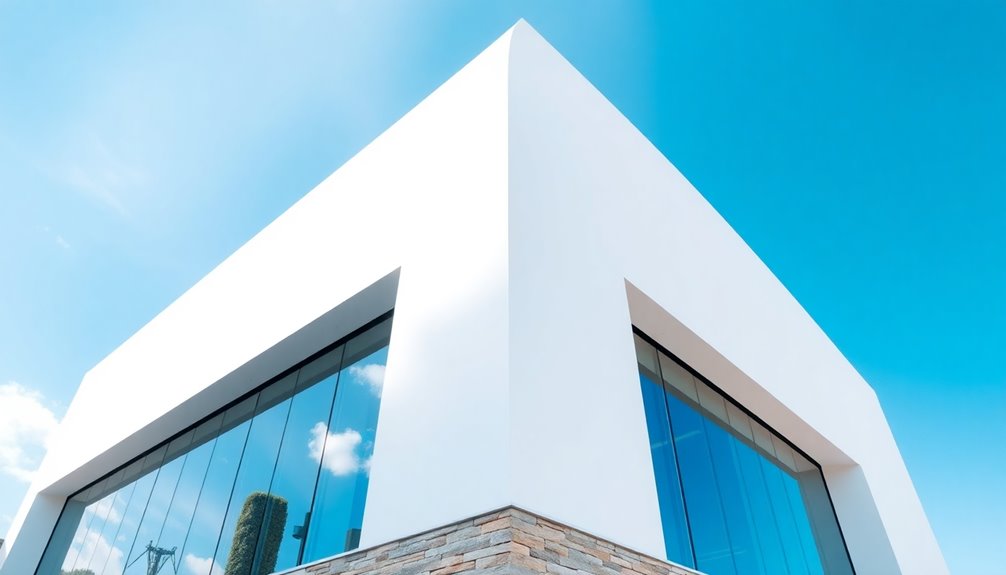
Color and material play an essential role in minimalist architecture, as they directly influence both the aesthetic and emotional impact of a space. A neutral color palette—think whites, grays, and earth tones—creates a calming atmosphere that promotes simplicity and visual harmony.
By carefully selecting materials like wood, concrete, glass, and metal, you add warmth and authenticity while preserving the clean lines characteristic of minimalist design. Maximizing natural light through large windows enhances the connection between color, material, and the environment, fostering well-being.
Furthermore, using raw, authentic materials aligns with minimalist principles and emphasizes sustainability. Attention to detail guarantees architectural features stand out without overwhelming the space, maintaining a sense of balance and clarity essential to minimalist spaces.
Innovations in Minimalist Architectural Design
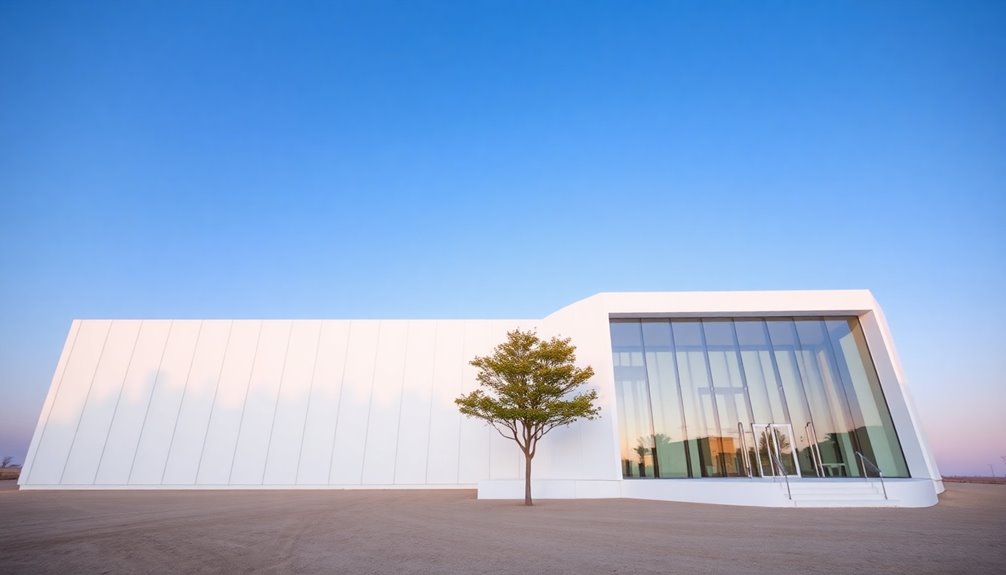
Minimalist architecture constantly evolves, pushing the boundaries of design through innovative materials and technologies.
By embracing clean lines and the seamless integration of glass and metal, architects create expansive open spaces that enhance natural light and foster well-being.
You'll find that contemporary designs prioritize energy efficiency, incorporating sustainable technologies for a greener future.
- Use of large panoramic windows for improved natural light
- Sliding window systems enhance visual connectivity
- High-quality craftsmanship guarantees minimal imperfections
Notable examples include Mies van der Rohe's Farnsworth House, showcasing the beauty of minimalist architecture.
Architectural innovations like passive heating and cooling systems, alongside a commitment to the circular economy, reflect a growing trend toward sustainable and innovative designs that redefine the minimalist aesthetic.
The Future of Minimalism in Architecture
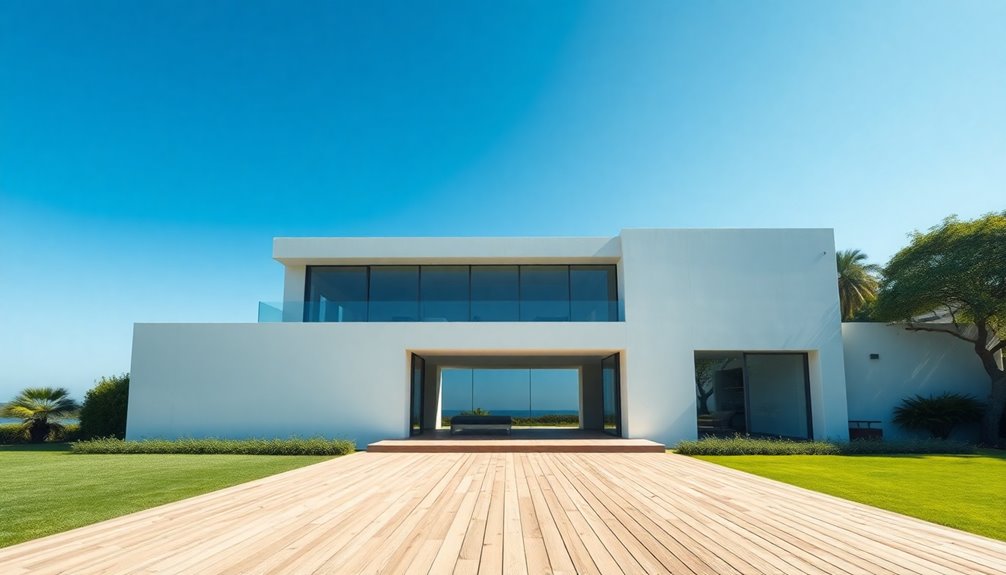
As architects look ahead, the future of minimalism in architecture is set to embrace sustainability at its core.
You'll see a shift toward eco-friendly materials and energy-efficient designs that not only reduce environmental impact but also enhance the beauty of minimalist architecture.
With urban congestion driving the need for open spaces, architects are creating environments that prioritize natural light and seamless indoor-outdoor connections.
Smart home technologies will further complement these designs, offering functionality without clutter and optimizing space efficiency.
As contemporary architects redefine minimalism, you can expect a balance between aesthetics and sustainability that reflects cultural context and environmental sensitivity, paving the way for a more harmonious coexistence with our surroundings.
Frequently Asked Questions
What Are Clean Lines in Architecture?
Clean lines in architecture refer to the use of straight, unembellished edges and forms that create a minimalist aesthetic.
You'll notice that this design approach emphasizes simplicity and functionality, minimizing ornamentation.
By focusing on geometric shapes and repetitive patterns, clean lines enhance balance and harmony in structures.
When you walk into a space with clean lines, you'll often feel an open, airy atmosphere that promotes natural light and connects the indoors to the outdoors.
What Are the Characteristics of Minimalist Architecture?
When you think about minimalist architecture, you'll notice several key characteristics. It focuses on functionality, stripping away unnecessary elements so every detail has a purpose.
You'll see clean lines and geometric shapes that promote visual clarity. Natural materials like wood and stone create a tranquil ambiance, while a neutral color palette enhances harmony.
Open spaces and abundant natural light contribute to a sense of freedom and well-being, making the environment feel calm and inviting.
What Style of House Is Known for Minimalism and Clean Straight Lines With Lots of Large Glass Windows?
Did you know that homes designed in the International Style can reduce energy costs by up to 40%?
If you're looking for a house characterized by minimalism and clean straight lines, you should explore this style. It features large glass windows that invite natural light and create open spaces.
Architects like Mies van der Rohe and Philip Johnson championed this approach, emphasizing functionality and a seamless connection with the outdoors.
Who Is the Father of Minimalism Architecture?
The father of minimalist architecture is Ludwig Mies van der Rohe.
You'll find his influence in iconic structures like the Barcelona Pavilion and the Farnsworth House.
Mies championed the idea of "less is more," focusing on clean lines and open spaces.
His work emerged from the Bauhaus movement, emphasizing function over form.
If you look at modern minimalist designs, you can see how Mies' principles continue to inspire architects today.
Conclusion
In the ever-evolving landscape of architecture, you'll find that minimalist masterpieces mesmerize with their mastery of minimalism. These structures showcase simplicity and serenity, proving that less truly is more. As you explore the enduring elegance of clean lines and thoughtful spaces, you'll appreciate how innovative ideas continue to shape the future. Embracing the beauty of bare essentials, minimalist architecture invites you to experience a harmonious haven where form meets function, fostering a timeless tranquility in your surroundings.
